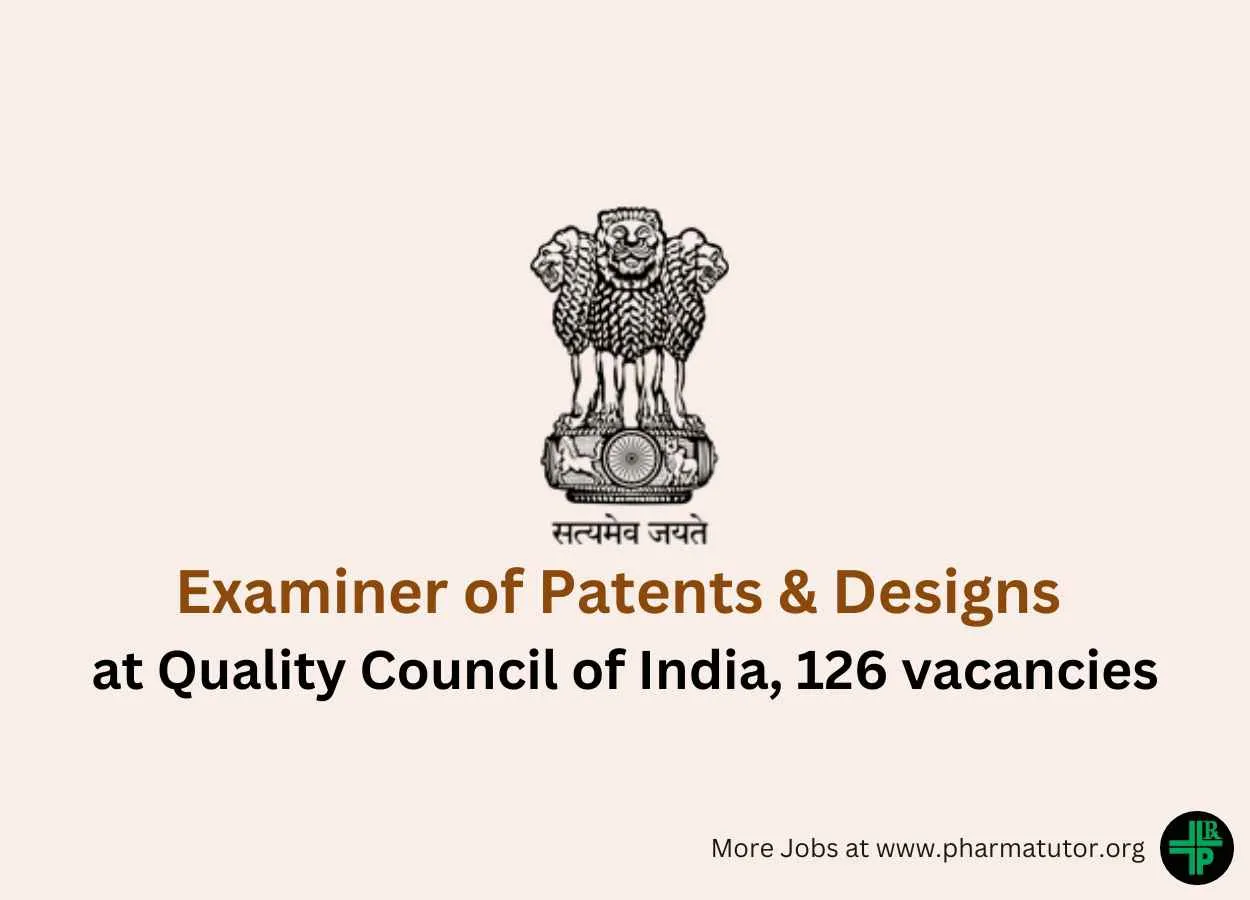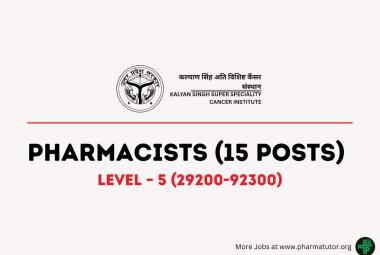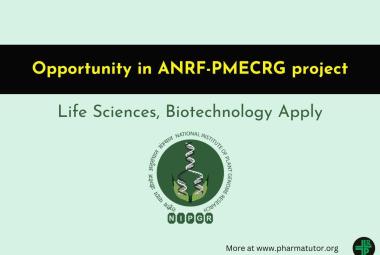Quality Council of India (QCI) was established as a National body for Accreditation on recommendations of Expert Mission of EU after consultations in Inter-ministerial Task Force, Committee of Secretaries and Group of Ministers through a Cabinet decision in 1996. Accordingly, QCI was set up through a PPP model as an independent autonomous organization with the support of Government of India and the Indian Industry represented by the three premier industry associations, (i) Associated Chambers of Commerce and Industry of India (ASSOCHAM), (ii) Confederation of Indian Industry (CII) and (iii) Federation of Indian Chambers of Commerce and Industry (FICCI).
Post : Examiner of Patents & Designs
Biotechnology Discipline
No of posts : 50 (SC-7, ST-3, OBC-14, EWS-5, UR-21)
Essential qualification : Master Degree in Bio-Technology/ Microbiology/ Molecular-Biology/ Bio Physics or equivalent
Bio-Chemistry Discipline
No of posts : 20 (SC-3, ST-1, OBC-5, EWS-2, UR-9)
Essential qualification : Master Degree in Biochemistry or equivalent
Chemistry Discipline
No of posts : 56 (SC-8, ST-3, OBC-15, EWS-6, UR-24)
Essential qualification : Master Degree in Chemistry or Bachelor Degree in Chemical Technology / Engineering or equivalent
General Instructions
All candidates are mandatorily required to read this Information Bulletin in its entirety. The candidates are required to ensure that they fulfill all conditions as contained in this Information Bulletin. Due to the large number of candidates that are expected to apply for appearing in this examination, electronic systems will be used to analyse the information submitted by candidates. Accordingly, the admission to various stages of the examination will be purely provisional and would be subject to physical verification of documents. Mere issue of e-Admit Card to the candidate will not imply that a candidature has been finally cleared by the Competent Authority. The process of verification of documents and various conditions prescribed in this document will be conducted after the declaration of final list of qualified candidates.
Examination Fees
There will be an examination fee of Rs. 1000/- (Rupees One Thousand only) for candidates belonging to General category and OBC category. For candidates belonging to SC /ST category, PWD/ Differently abled (PH) category and women applicants (from all categories) and any other person, the examination fee shall be Rs.500/- (Rupees Five Hundred only).
RELAXATION / CONCESSION
The crucial date for claim of any kind of benefit, that is, reservation, fee concession, 2 age-relaxation, etc., shall be last date of submission of application. The Competent Authority reserves the right to debar any candidate for any malpractice, including for a fraudulent claim of any kind of benefit / relaxation / concession.
Eligibility Conditions
NATIONALITY A candidate must be either:-
a) a citizen of India, or
b) a subject of Nepal, or
c) a subject of Bhutan, or
d) a Tibetan refugee who came over to India before 1st January, 1962 with the intention of permanently settling in India, or e) a person of Indian origin who has migrated from Pakistan, Burma, Sri Lanka, East African countries of Kenya, Uganda, the United Republic of Tanzania, Zambia, Malawi, Zaire, Ethiopia and Vietnam with the intention of permanently settling in India.
Provided that a candidate belonging to categories (b), (c), (d) and (e) shall be a person in whose favour a Certificate of eligibility has been issued by the Government of India on or before the last date of submission of application. Crucial date for claim of SC/ ST/ OBC/ EWS/ PwBD status or any other benefit viz. fee concession, reservation, age-relaxation, etc., where not specified otherwise, will be the last date of filling the online application.
A candidate in whose case a Certificate of eligibility is necessary, may be admitted to the examination but the offer of appointment may be given only after the verification of necessary eligibility Certificate issued to him/her by the Government of India.
AGE LIMIT AND AGE RELAXATION
a. A candidate must have attained the age of 21 years and must not have attained the age of 35 years as on the last date of submission of online application.
b. The upper age limit of 35 years will be relaxable by up to a maximum of 5 years, that is up to the maximum upper age limit of 40 years, in the case of Government servants in accordance with the instructions or orders issued by the Central Government.
c. The upper age limit prescribed above will be relaxable:
i. upto a maximum of five years if a candidate belongs to a Scheduled Caste or a Scheduled Tribe.
ii. upto a maximum of three years in the case of candidates belonging to Other Backward Classes who are eligible to avail reservation applicable to such candidates.
iii. upto a maximum of three years in the case of Defence Services personnel disabled in operations during hostilities with any foreign country or in a disturbed area and released as a consequence thereof. iv. upto a maximum of five years in the case of ex-servicemen including Commissioned Officers and ECOs/SSCOs who have rendered at least five years Military Service as on the date on which online application process concludes and have been released:
a. on completion of assignment (including those whose assignment is due to be completed within one year as on the date on which online application process concludes) otherwise than by way of dismissal or discharge on account of misconduct or inefficiency, or
b. on account of physical disability attributable to Military Service, or
c. on invalidment.
v. upto a maximum of five years in the case of ECOs/SSCOs who have completed an initial period of assignment of five years Military Service as on the date on which online application process concludes and whose assignment has been extended beyond five years and in whose case the Ministry of Defence issues a certificate that they can apply for civil employment and that they will be released on three month notice on selection from the date of receipt of offer of appointment.
vi. Upto a maximum of 10 years in the case of candidates belonging to Persons with Benchmark Disabilities (PwBD) categories viz.
a. Locomotor disability (OA, OL, OAL, BL) including cerebral palsy, leprosy cured, dwarfism, acid attach victims and muscular dystrophy.
b. Blindness and Low vision (VH)
c. Hard of hearing (HH) d. Multiple disabilities from amongst persons under clauses (a) to (c) except deaf-blindness.
Note I: Candidates belonging to the Scheduled Castes and the Scheduled Tribes and the Other Backward Classes who are also covered under any other clause 3(c) above, viz. those coming under the category of Ex-servicemen or PwBD, will be eligible for grant of cumulative age-relaxation under both the categories.
Note II: The term Ex-servicemen will apply to the persons who are defined as Ex- servicemen in the Ex-servicemen (Re-employment in Civil Services and Posts) Rules, 1979, as amended from time to time.
Note III: The age concession under clause 3(c)[(iv) and (v)] above will be admissible to Ex- Servicemen, i.e. a person who has served in the rank whether as combatant or non-combatant in the Regular Army, Navy and Air Force of the Indian Union and who either has been retired or relieved or discharged from such service whether at own request or being relieved by the employer after earning pension. Note IV: Notwithstanding the provision of age relaxation under clause 3(c)(vi) above, candidates of PwBD category will be considered to be eligible for appointment only if they (after such medical examination as the Government or appointing authority, as the case may be, may prescribe) are found to satisfy the requirements of physical and medical standards for the concerned posts to be allocated to the candidates of PwBD category by the Government.
Note V : Same as provided under clause 3(c) above, the age limits prescribed can in no case be relaxed. (Not understood) (d) The date of birth accepted by the Competent Authority is that entered in the Matriculation or Secondary School Leaving Certificate or in a Certificate recognized by an Indian University as equivalent to Matriculation or in an extract from a Register of Matriculates maintained by a University, which extract must be certified by the proper authority of the University or in the Higher Secondary or an equivalent examination Certificate. The certificate in support of date of birth is required to be submitted by a candidate at the time of online application. No other document relating to age like horoscopes, affidavits, birth extracts from Municipal Corporation, service records and the like will be accepted.
Note 1 : Candidates should note that only the date of birth as recorded in the matriculation/secondary examination certificate or an equivalent certificate as on the date of submission of applications will be accepted by the competent authority and issued prior to the date of submission of application will be accepted by the Competent Authority, and no subsequent request for its change will be considered or granted.
Note 2 : Candidates should also note that once a date of birth has been submitted by them in the application form and entered in the records of the competent authority for the purpose of admission to the examination, no change will be allowed subsequently (or at any other examination of the competent authority) on any grounds whatsoever.
Important Instructions to Candidates
a) No request for change in examination centre shall be entertained.
b) Rights for the rules for the cut off of the all stages for all the posts in the examination are reserved by CGPDTM
c) If a candidate fails in such tests, his candidature will not be subsequently considered for any other post/ department. Candidates are therefore required to carefully go through these requirements.
d) The final allotment of posts is being made on the basis of merit-cum-preferences and once a post is allotted, no change of posts will be made by the QCI.
e) Success in the examination confers no right of appointment unless QCI is satisfied after such enquiry as may be considered necessary that the candidate is suitable in all respects for appointment to the service/ post.
f) The candidates applying for the examination should ensure that they fulfill all the eligibility conditions for admission to the examination. Their admission at all stages of the examination will be purely provisional, subject to their satisfying the prescribed eligibility conditions. If, on verification, at any time before or after the written examination, it is found that they do not fulfill any of the eligibility conditions, their candidature for the examination will be cancelled.
g) If candidates are found to indulge at any stage in any of the malpractices and fraudery their candidature for this examination will be cancelled and legal actions shall be taken by QCI. QCI may also report the matter to Police/ Investigating Agencies, as deemed fit. h) Before applying, candidates must to go through the instructions given in the notice of examination very carefully.
i) Candidates seeking reservation benefits available for SC/ ST/ OBC/ EWS/ PwBD/ ESM must ensure that they are entitled to such reservation as per eligibility prescribed in the Notice.
j) The candidates must write their name, date of birth, father’s name and mother’s name strictly as given in the matriculation certificate otherwise their candidature may be cancelled at the time of Document Verification or as and when it comes into the notice of the commission.
k) Candidates are advised to fill their correct and active e-mail addresses and mobile number in the online application as correspondence may be made through e-mail/ SMS.
l) In case of fake/ fabricated application/ registration by misusing any dignitaries name/ photo, such candidate/ cyber cafe will be held responsible for the same and liable for suitable legal action under cyber/ IT Act. m) All decisions related to recruitment shall be made and enforced by QCI and will be applicable for all candidates.
SYLLABUS
Bio Technology
Microbiology : Prokaryotic and eukaryotic cell structure; Microbial nutrition, growth and control; Microbial metabolism (aerobic and anaerobic respiration, photosynthesis); Nitrogen fixation; Chemical basis of mutations and mutagens; Microbial genetics (plasmids, transformation, transduction, conjugation); Microbial diversity and characteristic features; Viruses.
Biochemistry : Biomolecules and their conformation; Weak inter-molecular interactions in biomacromolecules; Chemical and functional nature of enzymes; Kinetics of single substrate and bi-substrate enzyme catalyzed reactions; Bioenergetics; Metabolism (Glycolysis, TCA and Oxidative phosphorylation); Membrane transport and pumps; Cell cycle and cell growth control; Cell signaling and signal transduction.
Molecular Biology and Genetics : Molecular structure of genes and chromosomes; DNA replication and control; Transcription and its control; Translational processes; Regulatory controls in prokaryotes and eukaryotes; Mendelian inheritance; Gene interaction; Complementation; Linkage, recombination and chromosome mapping; Extrachromosomal inheritance; Chromosomal variation; Population genetics; Transposable elements, Molecular basis of genetic diseases and applications.
Process Biotechnology : Bioprocess technology for the production of cell biomass and primary/secondary metabolites, such as baker’s yeast, ethanol, citric acid, amino acids, exo-polysacharides, antibiotics and pigments etc.; Microbial production, purification and bioprocess application(s) of industrial enzymes; Production and purification of recombinant proteins on a large scale; Chromatographic and membrane based bioseparation methods; Immobilization of enzymes and cells and their application for bioconversion processes. Aerobic and anaerobic biological processes for stabilization of solid / liquid wastes; Bioremediation.
Bioprocess Engineering : Kinetics of microbial growth, substrate utilization and product formation; Simple structured models; Sterilization of air and media; Batch, fed-batch and continuous processes; Aeration and agitation; Mass transfer in bioreactors; Rheology of fermentation fluids; Scale-up concepts; Design of fermentation media; Various types of microbial and enzyme reactors; Instrumentation in bioreactors.
Plant and Animal Biotechnology : Special features and organization of plant cells; Totipotency; Regeneration of plants; Plant products of industrial importance; Biochemistry of major metabolic pathways and products; Autotrophic and heterotrophic growth; Plant growth regulators and elicitors; Cell suspension culture development : methodology, kinetics of growth and production formation, nutrient optimization; Production of secondary metabolites by plant suspension cultures; Hairy root cultures and their cultivation. Techniques in raising transgencies.
Characteristics of animal cells : Metabolism, regulation and nutritional requirements for mass cultivation of animal cell cultures; Kinetics of cell growth and product formation and effect of shear force; Product and substrate transport; Micro & macro-carrier culture; Hybridoma technology; Live stock improvement; Cloning in animals; Genetic engineering in animal cell culture; Animal cell
preservation.
Immunology : The origin of immunology; Inherent immunity; Humoral and cell mediated immunity; Primary and secondary lymphoid organ; Antigen; B and T cells and Macrophages; Major histocompatibility complex (MHC); Antigen processing and presentation; Synthesis of antibody and secretion; Molecular basis of antibody diversity; Polyclonal and monoclonal antibody; Complement; Antigen- antibody reaction; Regulation of immune response; Immune tolerance; Hyper sensitivity; Autoimmunity; Graft versus host reaction.
Recombinant DNA Technology : Restriction and modification enzymes; Vectors: plasmid, bacteriophage and other viral vectors, cosmids, Ti plasmid, yeast artificial chromosome; cDNA and genomic DNA library; Gene isolation; Gene cloning; Expression of cloned gene; Transposons and gene targeting; DNA labeling; DNA sequencing; Polymerase chain reactions; DNA fingerprinting; Southern and northern blotting; In-situ hybridization; RAPD; RFLP; Site-directed mutagenesis; Gene transfer technologies; Gene therapy.
Bioinformatics : Major bioinformatics resources (NCBI, EBI, ExPASy); Sequence and structure databases; Sequence analysis (biomolecular sequence file formats, scoring matrices, sequence alignment, phylogeny); Genomics and Proteomics (Large scale genome sequencing strategies; Comparative genomics; Understanding DNA microarrays and protein arrays); Molecular modeling and simulations (basic concepts including concept of force fields).
Bio-Chemistry
Organization of life. Importance of water. Cell structure and organelles. Structure and function of biomolecules: Amino acids, Carbohydrates, Lipids, Proteins and Nucleic acids. Biochemical separation techniques and characterization: ion 20 exchange, size exclusion and affinity chromatography, electrophoresis, UV- visible, fluorescence and Mass spectrometry. Protein structure, folding and function: Myoglobin, Hemoglobin, Lysozyme, Ribonuclease A, Carboxypeptidase and Chymotrypsin. Enzyme kinetics including its regulation and inhibition, Vitamins and Coenzymes. Metabolism and bioenergetics. Generation and utilization of ATP. Metabolic pathways and their regulation: glycolysis, TCA cycle, pentose phosphate pathway, oxidative phosphorylation, gluconeogenesis, glycogen and fatty acid metabolism. Metabolism of Nitrogen containing compounds: nitrogen fixation, amino acids and nucleotides. Photosynthesis: the Calvin cycle. Biological membranes. Transport across membranes. Signal transduction; hormones and Neurotransmitters. DNA replication, transcription and translation. Biochemical regulation of gene expression. Recombinant DNA technology and applications: PCR, site directed mutagenesis and DNA microarray. Immune system. Active and passive immunity. Complement system. Antibody structure, function and diversity. Cells of the immune system: T, B and macrophages. T and B cell activation. Major histocompatibilty complex. T cell receptor. Immunological techniques: Immunodiffusion, immune electrophoresis, RIA and ELISA.
Chemistry
Inorganic Chemistry
1. Chemical periodicity 2. Structure and bonding in homo- and heteronuclear molecules, including shapes of molecules (VSEPR Theory). 3. Concepts of acids and bases, Hard-Soft acid base concept, Non-aqueous solvents. 4. Main group elements and their compounds: Allotropy, synthesis, structure and bonding, industrial importance of the compounds. 5. Transition elements and coordination compounds: structure, bonding theories, spectral and magnetic properties, reaction mechanisms. 6. Inner transition elements: spectral and magnetic properties, redox chemistry, analytical applications. 7. Organometallic compounds: synthesis, bonding and structure, and reactivity. Organometallics in homogeneous catalysis. 8. Cages and metal clusters. 9. Analytical chemistry- separation, spectroscopic, electro- and thermoanalytical methods. 10. Bioinorganic chemistry: photosystems, porphyrins, metalloenzymes, oxygen transport, electron- transfer reactions; nitrogen fixation, metal complexes in medicine. 11. Characterisation of inorganic compounds by IR, Raman, NMR, EPR, Mössbauer, UV- vis, NQR, MS, electron spectroscopy and microscopic techniques. 12. Nuclear chemistry: nuclear reactions, fission and fusion, radio-analytical techniques and activation analysis.
Physical Chemistry
1. Basic principles of quantum mechanics: Postulates; operator algebra; exactly- solvable systems: particle-in-a-box, harmonic oscillator and the hydrogen atom, including shapes of atomic orbitals; orbital and spin angular momenta; tunneling. 2. Approximate methods of quantum mechanics: Variational principle; perturbation theory up to second order in energy; applications. 3. Atomic structure and spectroscopy; term symbols; many-electron systems and antisymmetry principle. 4. Chemical bonding in diatomics; elementary concepts of MO and VB theories; Huckel theory for conjugated π-electron systems. 5. Chemical applications of group theory; symmetry elements; point groups; character tables; selection rules. 6. Molecular spectroscopy: Rotational and vibrational spectra of diatomic molecules; electronic spectra; IR and Raman activities – selection rules; basic principles of magnetic resonance. 7. Chemical thermodynamics: Laws, state and path functions and their applications; thermodynamic description of various types of processes; Maxwell’s relations; spontaneity and equilibria; temperature and pressure dependence of thermodynamic quantities; Le Chatelier principle; elementary description of phase transitions; phase equilibria and phase rule; thermodynamics of ideal and non-ideal gases, and solutions. 8. Statistical thermodynamics: Boltzmann distribution; kinetic theory of gases; partition functions and their relation to thermodynamic quantities – calculations for model systems. 9. Electrochemistry: Nernst equation, redox systems, electrochemical cells; Debye-Huckel theory; electrolytic conductance – Kohlrausch’s law and its applications; ionic equilibria; conductometric and potentiometric titrations. 10. Chemical kinetics: Empirical rate laws and temperature dependence; complex reactions; steady state approximation; determination of reaction mechanisms; collision and transition state theories of rate constants; unimolecular reactions; enzyme kinetics; salt effects; homogeneous catalysis; photochemical reactions. 11. Colloids and surfaces: Stability and properties of colloids; isotherms and surface area; heterogeneous catalysis. 12. Solid state: Crystal structures; Bragg’s law and applications; band structure of solids. 13. Polymer chemistry: Molar masses; kinetics of polymerization. 14. Data analysis: Mean and standard deviation; absolute and relative errors; linear regression; covariance and correlation coefficient.
Organic Chemistry
1. IUPAC nomenclature of organic molecules including regio- and stereoisomers. 2. Principles of stereochemistry: Configurational and conformational isomerism in acyclic and cyclic compounds; stereogenicity, stereoselectivity, enantioselectivity, diastereoselectivity and asymmetric induction. 3. Aromaticity: Benzenoid and non-benzenoid compounds – generation and reactions. 4. Organic reactive intermediates: Generation, stability and reactivity of carbocations, carbanions, free radicals, carbenes, benzynes and nitrenes. 5. Organic reaction mechanisms involving addition, elimination and substitution reactions with electrophilic, nucleophilic or radical species. Determination of reaction pathways. 6. Common named reactions and rearrangements – applications in organic synthesis. 7. Organic transformations and reagents: Functional group interconversion including oxidations and reductions; common catalysts and reagents (organic, inorganic, organometallic and enzymatic). Chemo, regio and stereoselective transformations. 8. Concepts in organic synthesis: Retrosynthesis, disconnection, synthons, linear and convergent synthesis, umpolung of reactivity and protecting groups. 9. Asymmetric synthesis: Chiral auxiliaries, methods of asymmetric induction – substrate, reagent and catalyst controlled reactions; determination of enantiomeric and diastereomeric excess; enantio-discrimination. Resolution – optical and kinetic. 10. Pericyclic reactions – electrocyclisation, cycloaddition, sigmatropic rearrangements and other related concerted reactions. Principles and applications of photochemical reactions in organic chemistry. 11. Synthesis and reactivity of common heterocyclic compounds containing one or two heteroatoms (O, N, S). 12. Chemistry of natural products: Carbohydrates, proteins and peptides, fatty acids, nucleic acids, terpenes, steroids and alkaloids. Biogenesis of terpenoids and alkaloids. 13. Structure determination of organic compounds by IR, UV-Vis, 1H & 13C NMR and Mass spectroscopic techniques.
Interdisciplinary topics
1. Chemistry in nanoscience and technology 2. Catalysis and green chemistry 3. Medicinal chemistry 4. Supramolecular chemistry 5. Environmental chemistry
IMPORTANT DATES AT A GLANCE (TENTATIVE)
1. Online application process starts : 14th July 2023
2. Online application process concludes : 4th August 2023
3. Issuance of e-Admit Card for Preliminary Examination : 14th August 2023
4. Preliminary Examination : 3rd September 2023
5. Declaration of result of Preliminary Examination : 13th September 2023
6. Issuance of e-Admit Card for Mains Examination : 18th September 2023
7. Mains Examination : 1st October 2023
8. Declaration of result of Mains Examination : 16th October 2023
9. Issuance of e-Admit Card for Interview : 22nd October 2023
10. Interview : 11th and 12th November 2023
11. Declaration of final list of qualified candidates : 17th November 2023
See All Delhi Alerts B.Sc Alerts B.Pharm Alerts M.Pharm Alerts
See All Other Jobs in our Database









